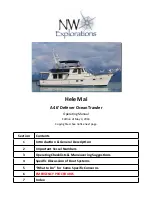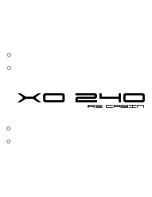
OPERATING INSTRUCTIONS
If the throttle lever is still pulled in
when releasing the iBR lever, the wa-
tercraft will accelerate forward after a
short delay. Acceleration will be pro-
portional to the throttle lever position.
WARNING
If forward acceleration is not de-
sired when the brake lever is re-
leased, release the throttle lever.
When at speed and the brake is first
applied, a plume of water will shoot up
in the air behind the watercraft which
may cause the operator of a following
watercraft to momentarily loose sight
of your PWC.
WARNING
– It is important to inform the
operator of a watercraft who
intends to follow in a convoy
formation, of the braking and
maneuvering capability of your
PWC, what the plume of water
indicates, and that a greater dis-
tance must be maintained be-
tween watercraft.
– Be aware that other boats fol-
lowing or operating in close
proximity may not be able to
stop as quickly.
Braking in a Turn
Braking can be initiated during a turn
using the iBR lever as previously de-
scribed. Get ready to maintain your
balance while the wake is crossing
your PWC.
CAUTION
As
the
watercraft
slows to a stop while braking in a
turn, the wake created by the water-
craft will catch up and tend to push
the watercraft sideways. Be pre-
pared to maintain balance as the
wake crossed the watercraft.
General Operating
Recommendations
Rough Water or Poor Visibility
Operation
Avoid operation in these conditions. If
you must do so, proceed with caution
using minimum speed.
Crossing Waves
The operator must grip the handlebar
firmly and keep both feet on the foot-
boards.
The passenger must grip the hand-
holds with both hands and keep both
feet on the footboards.
Reduce speed.
Always be prepared to steer and main-
tain your balance as necessary.
When going over waves, raise your
body slightly off the seat to absorb the
shocks with your legs.
When crossing wakes, always keep a
safe distance from watercraft ahead.
WARNING
When crossing wakes, slow down.
Operator and passenger(s) should
brace themselves and adopt a
semi-standing position to help
absorb the bumps. Do not jump
waves or wakes.
Stopping/Docking
When the throttle is released, the wa-
tercraft is slowed by water drag against
the hull. The stopping distance will
vary depending on the watercraft size,
weight, speed, water surface condi-
tion, presence and direction of wind
and current.
64
______________
Summary of Contents for 2014 Spark Series
Page 9: ...SAFETY INFORMATION ________ SAFETY INFORMATION ________ 7 ...
Page 42: ...PRE RIDE INSPECTION This page is intentionally blank 40 _______ SAFETY INFORMATION ________ ...
Page 43: ...WATERCRAFT INFORMATION _______________ 41 ...
Page 76: ...SPECIAL PROCEDURES This page is intentionally blank 74 ______________ ...
Page 77: ...MAINTENANCE INFORMATION _______________ 75 ...
Page 95: ......
Page 101: ...TECHNICAL INFORMATION _______________ 99 ...
Page 107: ...TROUBLESHOOTING ______________ 105 ...
Page 115: ...WARRANTY ______________ 113 ...
Page 134: ...This page is intentionally blank 132 ______________ ...
Page 135: ...CUSTOMER INFORMATION ______________ 133 ...
Page 138: ...CHANGE OF ADDRESS OWNERSHIP This page is intentionally blank 136 ______________ ...
Page 139: ......
Page 140: ...CHANGE OF ADDRESS OWNERSHIP 138 ______________ ...
Page 141: ......
Page 142: ...CHANGE OF ADDRESS OWNERSHIP 140 ______________ ...
Page 143: ...CHANGE OF ADDRESS OWNERSHIP NOTES ______________ 141 ...
Page 144: ...CHANGE OF ADDRESS OWNERSHIP NOTES 142 ______________ ...
Page 145: ...CHANGE OF ADDRESS OWNERSHIP NOTES ______________ 143 ...
Page 146: ...CHANGE OF ADDRESS OWNERSHIP NOTES 144 ______________ ...
Page 147: ......
















































